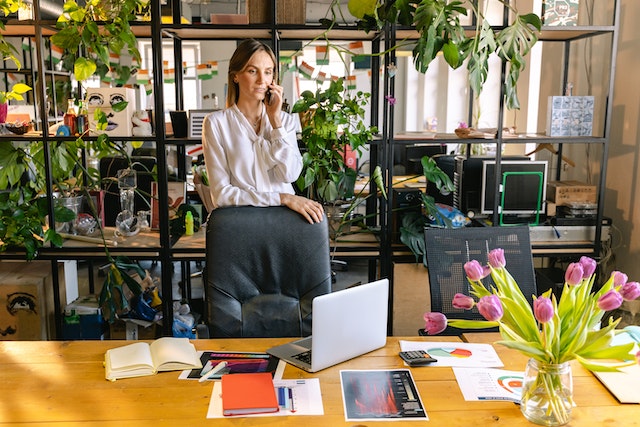
Welcome to a world where the boundaries between the indoors and outdoors are seamlessly blurred, where the hum of air conditioning is replaced by the rustle of leaves, and where steel and plastic give way to wood and stone. Welcome to the world of natural materials in office spaces. A world where nature and work coexist harmoniously, offering a breath of fresh air – quite literally – to office workers.
The integration of natural materials into office design isn’t just an aesthetic choice. It’s an increasingly popular trend that aligns with our innate desire to connect with nature – a concept known as biophilia. With an accelerated shift to remote working and flexible office spaces catalysed by recent global events, the focus has shifted to creating work environments that are not just functional, but also comfortable, calming, and inspiring.
This transformation goes beyond merely placing a few potted plants around the office or installing a green wall in the reception area. It involves a thoughtful infusion of natural elements into the very core of sustainable office design – from the choice of construction materials to furniture, and from energy efficient lighting to layout. The outcome? Spaces that promote wellbeing, creativity, and productivity, all while treading lightly on the planet.
The interest in this trend has seen a sharp upswing, with businesses large and small recognising the value of such spaces. Forward-thinking companies are putting employee wellbeing at the heart of their office design, embracing the therapeutic power of nature and incorporating natural light to reduce stress, enhance mood, and spur creativity. This positive shift towards sustainable and health-centric design practices signals a promising future for office spaces – a future where natural materials take root and flourish.
Join us as we explore this exciting realm where nature and sustainable office space coalesce, and discover why and how natural materials are fundamentally changing the way we work.
The Emergence of Biophilic Design in Office Spaces
Imagine walking into your office to be greeted not by the sterile glare of artificial lights, but by the warm glow of the sun streaming in through large windows. Your eyes wander across lush indoor plants, exposed brick walls, and wooden furniture. The sound of trickling water from a small indoor waterfall is in the air. This is not a scene from a dream or a spa resort; it’s what workplaces designed using biophilic principles could look like.
Biophilic design is an approach to architecture and interior design that seeks to connect building occupants more closely to nature. The term “biophilia” was popularised by biologist Edward O. Wilson in the 1980s, and it describes the inherent human inclination to affiliate with natural environments and living systems. Biophilic design takes this concept and applies it to spaces where we live, work, and play.
The benefits of biophilic design are manifold and profound. Several studies have pointed out that incorporating natural elements into the workplace can have significant positive impacts on the occupants’ wellbeing and productivity. For instance, it can reduce stress, improve cognitive function, enhance mood and creativity, and even expedite healing. When employees feel better, they perform better. They take fewer sick leaves, are more engaged, and are more likely to stay with the company – all contributing to a healthier bottom line.
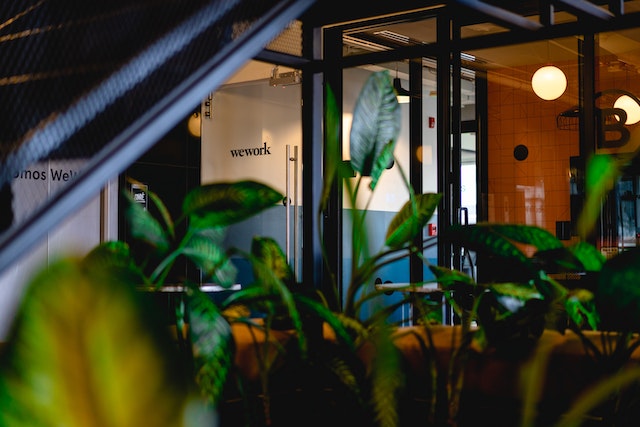
How Office-based Companies are Using Natural Materials
Using natural materials means more than just adding a few hanging baskets or replicating the ideas seen in a design magazine. Instead, it’s about using these materials intentionally, strategically, and in line with corporate values.
For example, luxury travel company Jacada gave its London office a makeover relying on natural and ethically sourced materials, and ensuring their choices were aligned with the company’s core values. Timber meeting room tables and bespoke desks were sourced from a supplier who shared the same ethical values and concern for the environment, as they planted hundreds of new trees to ensure the give and take ratio with nature was balanced. Other additions included plastic and chemical-free floor coverings and natural cork panels to embellish walkways and walls.
Another example comes from across the pond. The PAE Living Building in Portland, Oregon is a mixed-use development that has made extensive use of cross-laminated timber from Pacific Northwest forests, as well as salvaged wood and mass timber interiors. Cross-laminated timber is a natural alternative to concrete structures, as it’s obtained through sustainable forestry practices and has added advantages, like high carbon dioxide absorption properties and the scraps can be used to produce biofuel.
Back in the UK, the Black & White building in Shoreditch also shows that there are choices beyond concrete and steel. In this office building, walls, columns, and louvres are made of wood from oak, walnut, beech and spruce, whereas interiors are also rich in natural materials like cork and natural fibre textiles.
As more companies recognise the numerous benefits of biophilic design, the future of office spaces appears greener, brighter, and altogether more natural.
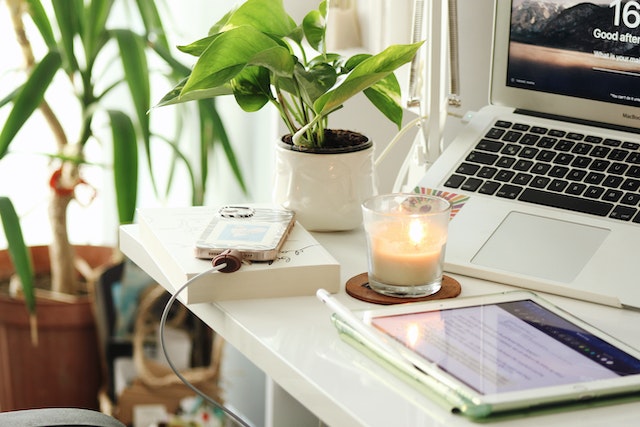
Benefits of Using Natural Materials in the Office
When we think about the benefits of using natural materials in the office, the advantages aren’t merely aesthetic. The gains span from personal health to global environmental conservation and energy costs, creating a compelling case for businesses to choose natural over synthetic.
Health Benefits
Working in an environment that feels natural can significantly enhance our wellbeing. For starters, natural materials can help improve indoor air quality. Certain indoor plants, for instance, are known to filter toxins and increase oxygen levels, leading to better respiratory health. Materials like untreated wood, cork, and bamboo do not emit harmful volatile organic compounds (VOCs), unlike many synthetic materials.
Moreover, surrounding oneself with natural elements can have profound psychological effects. According to numerous studies, exposure to nature or even just imagery of nature can lower blood pressure, reduce stress hormone production, and improve overall mood. This calming effect can help reduce anxiety and stress levels, making employees feel more comfortable and relaxed.
Productivity and Creativity Boost
Nature-inspired spaces aren’t just healthier; they’re also conducive to better work. A 2014 study published in the Journal of Experimental Psychology found that exposure to natural elements improved cognition and productivity. Researchers found that workers in spaces with natural features, like plants and sunlight, had higher cognitive scores and reported feeling more focused and satisfied.
Moreover, the calming influence of nature can stimulate our creative side. By reducing mental fatigue and stress, natural elements can foster a state of relaxed alertness, ideal for creative thinking and problem-solving. This means a greener, more sustainable office could be a more innovative one too.
Sustainability Benefits
Embracing natural materials isn’t just good for office workers; it’s also beneficial for the planet. Natural materials, especially when sourced responsibly, are renewable and have a lower environmental impact compared to synthetic alternatives. For instance, using reclaimed wood for furniture or structural elements not only adds a rustic charm, but also reduces the demand for deforestation.
Moreover, many natural materials are biodegradable, meaning they won’t contribute to landfill waste when their tenure in the office comes to an end. This characteristic, combined with the potential for recycling and repurposing, makes natural materials a more sustainable choice for the office.
In a world where sustainability is no longer a luxury but a necessity, adopting natural materials in office design serves as a tangible step towards a greener future. Companies that do so are not only investing in the wellbeing and productivity of their employees, but also making a commitment to the environment – a commitment that won’t go unnoticed by environmentally-conscious consumers and potential recruits.
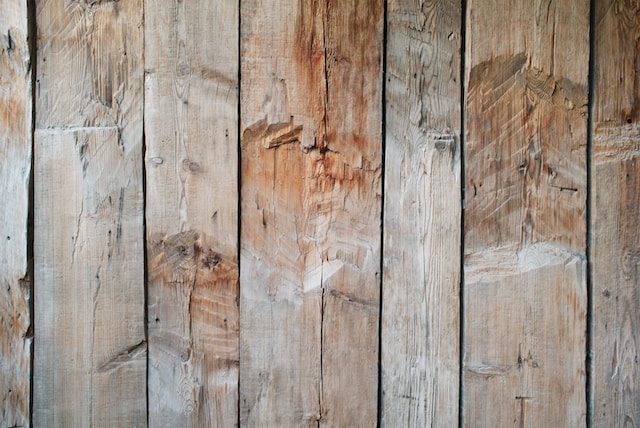
Types of Natural Materials Taking Root in Sustainable Offices
As businesses increasingly embrace the biophilic design ethos, a variety of natural materials are making their way into modern offices. These materials not only enhance the aesthetics of a workplace, but also contribute to healthier, more vibrant spaces. Let’s explore some of these elements that are transforming workplaces.
Wood
A timeless material, wood is widely used in office interiors – from floors and walls to furniture and decorative elements. Besides adding warmth and charm, wood has been associated with reducing stress and promoting relaxation. Furthermore, reclaimed or responsibly-sourced wood offers a sustainable choice. Google’s UK headquarters, for instance, prominently feature timber in their office interior design, creating a cosy and homely ambience.
Stone
Natural stone such as granite, marble, and slate can bring an element of grandeur and durability to office interiors. Aside from their aesthetic appeal, these materials can also improve indoor air quality as they do not off-gas VOCs. LinkedIn’s EMEA HQ in Dublin exhibits an excellent use of stone materials, where their polished concrete floors and columns create a sleek and modern look.
Plants
Indoor plants are one of the simplest ways to introduce nature into the workplace. Not only do they clean the air, but they also contribute to reducing stress and improving concentration. The use of green walls or vertical gardens is an increasingly popular trend, adding a wow factor and significantly increasing the number of plants in the office without eating up floor space. Etsy’s headquarters in Brooklyn, for instance, have a living wall that helps purify the air and create a calming environment.
Natural Fibres
Materials like cotton, wool, bamboo, and sisal can be used in everything from sustainable office furniture to carpets and window coverings. These materials are generally durable, biodegradable, and provide textural diversity, which can enhance the sensory experience of a space. Innocent Drinks’ Fruit Towers, as mentioned earlier, uses AstroTurf and other natural materials to create a unique, playful, and comforting workspace.
Natural Light
While not a material, natural light plays an integral part in biophilic design. Workspaces that maximise natural light can improve mood, reduce fatigue, and decrease dependence on artificial lighting. The Edge in London, a building known for its smart design and sustainability, utilises a transparent glass facade and a smart LED lighting system to optimise natural light.
Water
Incorporating water features, like indoor fountains or aquariums, can introduce a calming element into office spaces. The sound of flowing water can have a soothing effect and can also act as white noise, reducing distractions. Amazon’s ‘The Spheres’ in Seattle feature waterfalls and a river, adding to the immersive biophilic design.
Embracing natural materials in office design can lead to spaces that are not only visually appealing but also promote wellbeing, productivity, and environmental sustainability. As we move forward, the blending of the outdoors with our indoor workspaces looks set to become the rule rather than the exception.
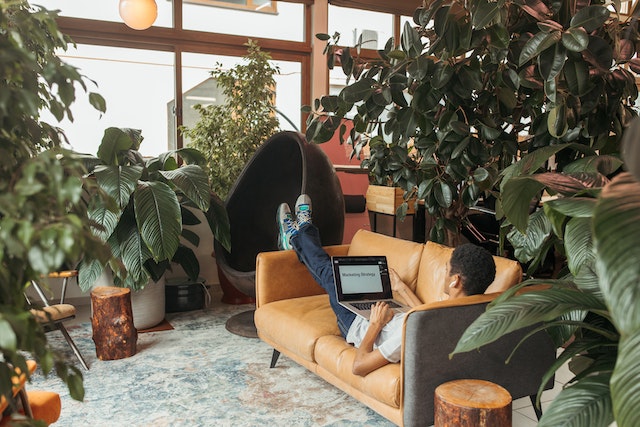
Incorporating Natural Elements in Sustainable Office Design: Practical Tips
Incorporating natural elements into an office doesn’t necessarily require a complete renovation or a big budget. With a thoughtful approach, it’s entirely possible to inject a touch of nature into your workspace in meaningful ways. Here are some practical tips to get you started:
Choose Furniture Made of Natural Materials
Where possible, opt for furniture made of natural materials such as wood, rattan, or cork. This might include desks, chairs, shelves, or cabinets. If you’re selecting wood, consider options like bamboo or reclaimed wood for a sustainable choice. Even small details, like replacing plastic desk organisers with ones made from wood or metal, can make a noticeable difference.
Consider Your Decorations
Decorative elements offer an easy way to bring a touch of nature into your office. Try swapping synthetic rugs or carpets with ones made from natural fibres like wool or jute. Use stone or ceramic containers for stationery on your desks. Hang artwork that depicts nature scenes. Even a wooden clock or stone paperweights can enhance the natural ambience.
Layout Matters
The layout of your office can also contribute to a more natural feel. If possible, arrange workspaces and common areas to maximise exposure to windows and natural light. Consider open-plan layouts that allow light to flow freely throughout the space.
Maximise Natural Light
Natural light is a crucial component of biophilic design. Make the most of it by keeping window areas unobstructed. Opt for light, sheer curtains or blinds that can be easily opened or adjusted to control glare. Consider installing skylights in areas far from windows. If natural light is limited, mimic it with full-spectrum light bulbs that replicate daylight.
Bring in the Green
Indoor plants are a fantastic way to bring nature into the office. They come in various shapes, sizes, and maintenance levels, so you can find something that suits your space and capacity to care for them. Use a mix of potted plants, hanging plants, and small desktop plants to introduce greenery at multiple levels. If space allows, consider installing a green wall for a striking focal point.
Incorporate Water Elements
If it’s feasible, water features can add a dynamic and soothing element to your workspace. This could be as simple as a small tabletop fountain in a common area or as grand as a large wall-mounted waterfall in the reception area.
Use Natural Colours and Textures
Even if you can’t bring in many physical elements of nature, you can evoke a natural feel with your colour palette. Opt for earth tones like greens, browns, and blues. Also, consider using wallpapers or paints that mimic natural textures, such as wood grain or stone.
Incorporating natural elements into your office design is more than a design trend. It’s a step towards creating healthier, happier, and more productive workplaces that celebrate our intrinsic connection to nature. Whether you’re starting from scratch or looking to make small changes, there are numerous ways to bring the benefits of nature into your workspace.
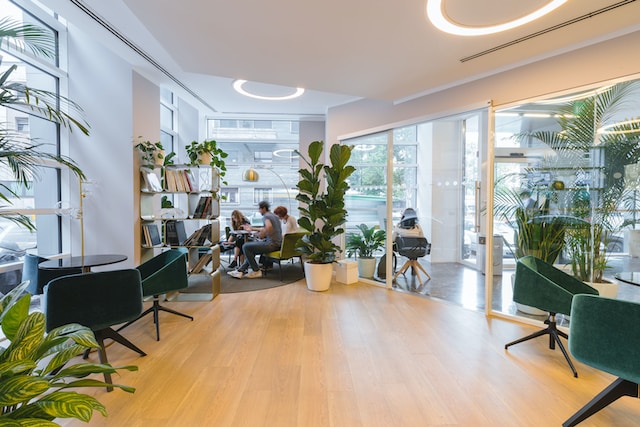
The Future of Sustainable Offices: What to Expect
As we look to the future of office design, the trend towards natural and sustainable materials shows no signs of slowing down. With the ongoing global emphasis on sustainability, health and wellness, businesses are increasingly recognising the need to align their offices with these values. The workplaces of the future are set to be greener, healthier, and more human-centric than ever before.
Continued Use of Natural Materials
We can expect the continued rise of natural and sustainable materials in office design. As more businesses and consumers prioritise sustainability, demand for furniture and fixtures made from renewable, non-toxic, and recycled materials will grow. The increasing popularity of certifications like LEED and WELL, which reward sustainable, energy efficient and health-promoting design practices, will further drive this trend.
Innovative Technologies and Practices
Technological innovation will play a significant role in facilitating the adoption of natural elements in offices. One example is the living wall or green wall systems, which are becoming more sophisticated and easier to maintain. We’re also likely to see more advanced natural ventilation systems, which use architectural design and smart technology to regulate indoor air temperature and quality using fresh outdoor air.
Moreover, innovative practices like biomimicry – design inspired by nature’s structures and processes – may become more prevalent. This might mean office layouts that mimic natural landscapes or the use of materials and designs that emulate nature’s resilience and efficiency.
Architects and Designers at the Forefront
Architects and designers have a crucial role to play in the evolution of sustainable office design. Their choices can significantly influence the wellbeing of office workers and the environmental impact of buildings. We can expect to see them pioneering new ways to incorporate nature into workplaces, pushing the boundaries of what’s possible with natural materials, and advocating for sustainable practices.
Furthermore, as remote and flexible working arrangements become more commonplace, designers will need to create spaces that are not only functional and sustainable but also adaptable to changing needs. This could involve designing multipurpose spaces that can easily be rearranged, using modular furniture made from sustainable materials, or incorporating movable green elements.
Looking ahead, the future of office design seems exciting and promising. As we continue to explore and embrace the manifold benefits of natural materials, we can anticipate workspaces that aren’t merely places to work, but environments that nurture our wellbeing, stimulate our creativity, and tread lightly on our planet.

Wrapping Up
As we’ve explored, the use of natural materials in office spaces is more than just a design trend—it’s a strategic approach that can profoundly impact the wellbeing, productivity, and creativity of employees. Additionally, it serves as a firm commitment to sustainability, a key value in our increasingly environmentally-conscious world.
Incorporating elements like wood, stone, plants, and natural fibres into an office environment not only fosters a sense of tranquillity but also offers tangible health benefits, including improved air quality and reduced stress levels. The added bonus of boosting productivity and creativity further strengthens the case for embracing natural materials in our workplaces.
Businesses of all sizes and industries should consider this approach when designing or renovating their offices. Whether you’re taking small steps like adding indoor plants and maximising natural light, or making significant changes like installing living walls and adopting sustainable furniture, these efforts can lead to more vibrant, healthier, and more environmentally friendly workplaces.
Looking for Office Space in the United Kingdom?
At Prime Office Space, we are proud to offer serviced office spaces across the UK that embrace these principles. Many of our properties feature elements like abundant natural light, green spaces, and design details that emphasise natural materials, creating environments where businesses can thrive.
We invite you to explore our diverse range of office spaces and discover the perfect place to grow your business in harmony with nature. Our team is on hand to help you find a workspace that suits your unique needs, tastes, and aspirations.
In the era of sustainability, let’s reshape our workplaces into spaces that not only support us in our work, but also nurture our connection to the natural world.

